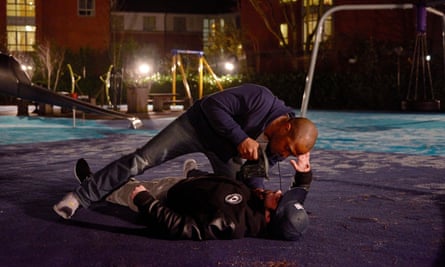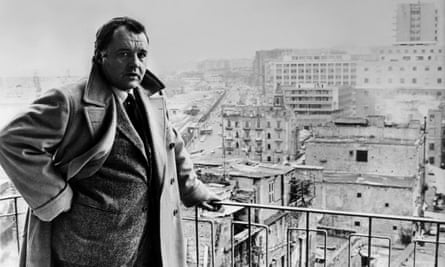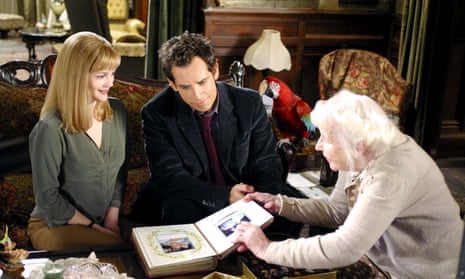There have been great movies about gentrification, and maybe cinema is itself a quasi-gentrification experience – creating tourist jaunts of the mind which allow audiences a short-lease habitation on attractive city locations and idealised city lives. Those places get smartened up, sentimentalised and homogenised by the camera, edited in a hundred subtle ways, their tougher neighbourhoods romanticised and repackaged as the appropriately dramatic arena for a personal journey.
Intentionally or not, the key movie about gentrification of recent times is Mike Newell’s upscale romcom Notting Hill (1999), with Hugh Grant as the loveable, floppy-haired English bookstore owner who falls hopelessly for an impossibly glamorous visiting movie star, played by Julia Roberts.
Grant lives in one of west London’s smartest neighbourhoods, famed for its trendiness. But how about the non-white people who have lived there, and in adjoining areas such as Westbourne Park, from the 1950s onwards? It’s a likable movie, but Notting Hill manages to avoid showing them or mentioning the Notting Hill carnival (despite a year-round montage explicitly showing Portobello Market) – and the area’s immigrant history is actually the foundation for Notting Hill’s attractive bohemian reputation. It’s a very different west London from, say, the urban crime thrillers of Noel Clarke – Kidulthood, Adulthood and Brotherhood – which show the lack British experience there.

But sometimes films have to reflect a newly gentrified reality. The Boston columnist Charlotte Wilder has railed against movies that have failed to gentrify her city. These are films like Martin Scorsese’s The Departed, Clint Eastwood’s Mystic River and Ben Wheatley’s forthcoming Free Fire. Wilder was impatient with films which incessantly hark back to Boston’s gritty past and stereotype the place as the unvarying location for tough guys with exaggerated drama-school Bawwwwston accents. Now, the neighbourhoods of those films are largely gone or changed beyond recognition; so why not make a non-crime picture about this new situation? Is there something condescending and politically correct about a failure to gentrify?
Gentrification in cinema is bound up in class, race, sense of self – and genre. A tough realist drama does not care to gentrify, but a romcom might take things a little upscale. Perhaps the most famous speech on the subject comes from Lawrence Fishburne’s character Jason “Furious” Styles in John Singleton’s Boyz N The Hood (1991). He points out to two African-American kids a real estate billboard in their South Central Los Angeles neighbourhood and asks them what they see: “I’m talking about the message. What it stands for. It’s called ‘gentrification.’ It’s what happens when the property value of a certain area is brought down … They can buy the land at a lower price. Then they move the people out, raise the value and sell it at a profit. What we need to do is we need to keep everything in our neighbourhood, everything, black. Black-owned with black money. Just like the Jews, the Italians, the Mexicans and the Koreans do.”
That is a bold, atypically political analysis of what gentrification is. Usually, the implications of class are invisibly embedded in our generic expectations of cinema. In Paris, for example, an elegant comedy by someone like Agnès Jaoui will bring us to the smarter arrondisements; but a tough social drama such as Mathieu Kassovitz’s La Haine (1995) or Céline Sciamma’s Girlhood (2014) finds its natural home in the council estates, the banlieues, visiting the posher areas in order to shoplift or to transgress, to feel dramatically and importantly out of place.
So what happens when the twain meet, when the middle classes encroach on a downmarket neighbourhood – and when gentrification starts happening? There are two generic modes here: horror and comedy. The “haunted house” movie is a gentrification movie. You move in to a picturesque but slightly creepy house, with all your upwardly mobile newness – only to find that the terrible spirits of the past are still around, punishing you for trespassing on their turf.

Poltergeist (1982), directed by Tobe Hooper and written and produced by Steven Spielberg is about a real estate developer who lives with his family in a chi-chi planned community in California. Terrifying ghosts show up because their house was built on top of a burial ground. That’ll teach them to gentrify these poor souls’ last resting place.
The other gentrification genre is satire – a satire of class and caste, sometimes dark, sometimes funny. Danny DeVito’s Duplex (2003) has Ben Stiller and Drew Barrymore as a yuppie New York couple who find a very attractively underpriced brownstone property in Brooklyn – the district that has now become a global byword for gentrification. But there is a sitting tenant on the apartment on the top floor: an old lady who has been there since Brooklyn was a shabby part of town that no-one liked. Sentimentally, they let her stay on, assuming she will die soon, allowing them to further develop and increase their property’s value. But she toughly stays alive, the upstairs neighbour from hell, making life a misery for them.
Ira Sachs’s Little Men (2016) has a similar idea, though treated with more nuance: Greg Kinnear and Jennifer Ehle play a struggling actor and his wife who get lucky when they inherit a huge apartment in – where else? – Brooklyn. But Kinnear needs money and he’s soon faced with having to increase the peppercorn rent they are currently charging to the family on the first floor with whom they have become friends.
John Schlesinger’s psychological thriller Pacific Heights (1990) has a similar theme, although the fancy San Francisco neighbourhood of the title needs no gentrifying. Melanie Griffith and Matthew Modine are the couple, and their tenant from hell is Michael Keaton. Again, the issues at stake are ownership and territory and the need to conceal the naked rage under the mask of civility. Perhaps the most complex “eviction drama” is Hal Ashby’s The Landlord (1970) about a rich young guy who buys a tenement in – presciently – Brooklyn, planning to evict the tenants, but instead becomes fond of them, an emotional development replete with a kind of paternalist condescension.

There is another kind of gentrification movie: the municipal corruption thriller. In Roman Polanski’s Chinatown (1974), set in 1920s Los Angeles, the beat-up private detective played by Jack Nicholson discovers that the city’s water department is drying up land so that it can be bought up cheap. It’s precisely the definition of “gentrification” proposed by Styles in Boyz N the Hood.
Francesco Rosi’s Hands Over the City (1962) is a classic of what you might call political or top-down gentrification: the decisions made about land by the the rich and powerful rather than the matter of the incremental inch-by-inch gentrification whereby nice middle-class people show up and start squeezing out the locals. Here Rod Steiger plays a corrupt developer who bribes city officials to let him create a huge new suburban estate . It should be a paradise for upwardly mobile, but one of his shoddy buildings collapses.
My favourite “gentrification” is a sharp London satire which sketches out in a microcosm the whole history of the subject, but with gentle topnotes of sympathy and understanding. It is Jack Gold’s The Chain (1984), written by Jack Rosenthal – a portmanteau movie, in effect, about seven sets of people owho move into each other’s properties, from the rough east London by stages up to super-posh Knightsbridge. Unlike a lot of film and TV drama set in London, Rosenthal’s screenplay shows what we would come to recognise as the diversity of London, with a line in anti-racist and anti-sexist humour. It is the acceptable face of gentrification.
Are you experiencing or resisting gentrification in your city? Share your stories in the comments below, through our dedicated callout, or on Twitter using #GlobalGentrification
Producing in-depth, thoughtful, well-reported journalism is difficult and expensive – but supporting us isn’t. If you value the the Guardian’s coverage of the global housing crisis, please help to fund our journalism by becoming a supporter

Comments (…)
Sign in or create your Guardian account to join the discussion